What a most excellent adventure! What a fun read. I’m so happy I was reading about it though instead of being there myself. ;)
February 1st | by Katherine King, Nate Gunesch, Emma Ramirez-Richer and Anika Heilweil
We can’t take credit for inventing the five peaks challenge. I don’t know who cooked up the original version, but it always seemed like a straightforward adventure: Hike all of Vermont’s 4000-footers in 24 hours. Of course, these things never stay simple. At some point, I learned of one person who pulled the whole thing off without a car, biking from trailhead to trailhead. Then, I learned about our visionaries (fondly, Fo’ and his boys), who did the whole thing in the winter. On skis.
The concept bit me several years ago. A mentor of mine told me about it. When he told me the story, I sensed the hint of a challenge: Could you pull it off? So, after living in Burlington for a few years and developing a rough knowledge of the skiing in the region, I decided it was time to assemble the team.
Each member’s ready willingness to hop on the train speaks to her spirit (and, to some extent, her sanity). Presented with the idea, Anika didn’t miss a beat. She grinned and asked “When?” If Emma showed any trepidation, it faded quickly, replaced by excitement. And Katherine—perhaps craziest of all—threw herself into the project despite learning about it only a few days beforehand. The perfect crew.
We also can’t claim to have succeeded. It turns out that pulling this off requires a lot of natural snow—which, last March, there was not.
I like to think that our difficulties were not a function of our preparedness or our fitness. And I am confident that it was not due to a lack of enthusiasm or grit. We had those in spades.
As with any wacky, outdoorsy outing, one of the most fun parts was the planning process. For weeks, we debated the best order to attempt the mountains. North to south, south to north? Some mishmash? What about the touring rules of the ski areas? We went out on scouting missions. We plotted out the timeline. If we summited Camel’s Hump by midday, we’d be on track. We planned our snack strategy meticulously. Emma would bring the bagel sandwiches. I brought chocolate cake and Cokes. Swedish Fish and Snickers, absolute musts.
The day before, we stashed a car near Sugarbush. We carbo-loaded. We triple-checked the weather. A storm would roll in the next evening, but with a bit of luck, we would be half way up Killington by then. (In hindsight, we probably should have anticipated that the lack of snow would slow us down. Anika claims that she raised this concern at the time, though the rest of us have no memory of that.)
Besides, it was March. We figured it was our last shot. Nothing short of a full-on blizzard would stop us. With this crew, I felt I could accomplish anything—I still do. And, hey—why do something called a ‘challenge’ if it isn’t going to be a little hard?
We can’t take credit for inventing the five peaks challenge. I don’t know who cooked up the original version, but it always seemed like a straightforward adventure: Hike all of Vermont’s 4000-footers in 24 hours. Of course, these things never stay simple. At some point, I learned of one person who pulled the whole thing off without a car, biking from trailhead to trailhead. Then, I learned about our visionaries (fondly, Fo’ and his boys), who did the whole thing in the winter. On skis.
The concept bit me several years ago. A mentor of mine told me about it. When he told me the story, I sensed the hint of a challenge: Could you pull it off? So, after living in Burlington for a few years and developing a rough knowledge of the skiing in the region, I decided it was time to assemble the team.
Each member’s ready willingness to hop on the train speaks to her spirit (and, to some extent, her sanity). Presented with the idea, Anika didn’t miss a beat. She grinned and asked “When?” If Emma showed any trepidation, it faded quickly, replaced by excitement. And Katherine—perhaps craziest of all—threw herself into the project despite learning about it only a few days beforehand. The perfect crew.
We also can’t claim to have succeeded. It turns out that pulling this off requires a lot of natural snow—which, last March, there was not.
I like to think that our difficulties were not a function of our preparedness or our fitness. And I am confident that it was not due to a lack of enthusiasm or grit. We had those in spades.
As with any wacky, outdoorsy outing, one of the most fun parts was the planning process. For weeks, we debated the best order to attempt the mountains. North to south, south to north? Some mishmash? What about the touring rules of the ski areas? We went out on scouting missions. We plotted out the timeline. If we summited Camel’s Hump by midday, we’d be on track. We planned our snack strategy meticulously. Emma would bring the bagel sandwiches. I brought chocolate cake and Cokes. Swedish Fish and Snickers, absolute musts.
The day before, we stashed a car near Sugarbush. We carbo-loaded. We triple-checked the weather. A storm would roll in the next evening, but with a bit of luck, we would be half way up Killington by then. (In hindsight, we probably should have anticipated that the lack of snow would slow us down. Anika claims that she raised this concern at the time, though the rest of us have no memory of that.)
Besides, it was March. We figured it was our last shot. Nothing short of a full-on blizzard would stop us. With this crew, I felt I could accomplish anything—I still do. And, hey—why do something called a ‘challenge’ if it isn’t going to be a little hard?
We rolled out of Burlington at 3am, arriving at the Stowe parking lot at 3:45. By 4am, the adventure had officially begun.
We rolled out of Burlington at 3am, arriving at the Stowe parking lot at 3:45. By 4am, the adventure had officially begun.
Skinning up the trail, excitement was in the air. To reach the peak, we planned to follow a small chute, which we would boot pack up to the ridge, before traversing to the summit. A clear path headed up from the gondola clearing, though low snow conditions quickly transformed a skin track to a boot pack. We bushwhacked through tighter and tighter brush until the trail disappeared altogether. Finally, we fought our way to the bottom of the chute, only to discover that it was blocked by a large boulder.
Nate ascended quickly, tossing his gear to the top of the rock and scrambling up the boulder with ease. Emma and Katherine followed, each managing to hoist themselves and their gear to the top of the pitch. I watched apprehensively. As someone who is profoundly bad at climbing, bouldering, and scrambling, it would not be my first time thwarted by a rock.
Luckily, Nate, the optimist he is, did not see the end so clearly. Giving me a hand, he pulled me up the 6-foot rock face, complete with words of encouragement and affirmations.
The remaining walk was uneventful until we reached the ridge, where wind gusts threatened to knock us over the edge. We stayed as low as possible, dropping to our knees during the fiercest gusts. Ultimately, we decided that the final 100 feet was too dangerous to ascend, and we turned around.
For all the excitement of the ascent, the descent was largely uneventful. We walked down the ridge and put on our skis at the top of the chute. Down the shoot we hop-turned, until a short bushwhack got us to the top of the gondola again. The easy ski down Stowe felt like a gift.
We arrived back at our car, quickly changed out of boots, and each ate our second breakfast sandwich. We drove away from Stowe just as resort skiers began to arrive, headed toward Camel’s Hump. It was 7:45am.
Skinning up the trail, excitement was in the air. To reach the peak, we planned to follow a small chute, which we would boot pack up to the ridge, before traversing to the summit. A clear path headed up from the gondola clearing, though low snow conditions quickly transformed a skin track to a boot pack. We bushwhacked through tighter and tighter brush until the trail disappeared altogether. Finally, we fought our way to the bottom of the chute, only to discover that it was blocked by a large boulder.
Nate ascended quickly, tossing his gear to the top of the rock and scrambling up the boulder with ease. Emma and Katherine followed, each managing to hoist themselves and their gear to the top of the pitch. I watched apprehensively. As someone who is profoundly bad at climbing, bouldering, and scrambling, it would not be my first time thwarted by a rock.
Luckily, Nate, the optimist he is, did not see the end so clearly. Giving me a hand, he pulled me up the 6-foot rock face, complete with words of encouragement and affirmations.
The remaining walk was uneventful until we reached the ridge, where wind gusts threatened to knock us over the edge. We stayed as low as possible, dropping to our knees during the fiercest gusts. Ultimately, we decided that the final 100 feet was too dangerous to ascend, and we turned around.
For all the excitement of the ascent, the descent was largely uneventful. We walked down the ridge and put on our skis at the top of the chute. Down the shoot we hop-turned, until a short bushwhack got us to the top of the gondola again. The easy ski down Stowe felt like a gift.
We arrived back at our car, quickly changed out of boots, and each ate our second breakfast sandwich. We drove away from Stowe just as resort skiers began to arrive, headed toward Camel’s Hump. It was 7:45am.
After a pit stop at the pharmacy for blister band-aids, we made it to our next staging area at the Monroe Trailhead. We arrived around 9:15am. As other hikers in the parking lot slipped on their microspikes, we made the quick assessment we would need to do the same. Natural snow cover in the woods around the parking lot was patchy at best. Surely, the snow pack would improve as we ascended, right?
We strapped our skis and boots to our packs, receiving puzzled looks from hikers as they passed us. (Probably wondering what we were seeing that they weren’t.) Hoisting our unruly packs onto our shoulders, we started down the trail, feeling smug to be carrying the only skis that would be seen on the mountain that day.
As we walked, we talked timeline: “How long should this take us?” The consensus seemed to be that it would take us about four hours. There is no way that’s happening, I thought to myself. Having hiked this trail before, I knew it could take three hours to summit in the summer, let alone descend. And in these conditions? But, as a late addition to the crew, having decided to join just 36 hours prior, I didn’t want to bring us down. Vibes were still surprisingly high. I’d let the others come to the realization themselves. This was going to take a while.
After a pit stop at the pharmacy for blister band-aids, we made it to our next staging area at the Monroe Trailhead. We arrived around 9:15am. As other hikers in the parking lot slipped on their microspikes, we made the quick assessment we would need to do the same. Natural snow cover in the woods around the parking lot was patchy at best. Surely, the snow pack would improve as we ascended, right?
We strapped our skis and boots to our packs, receiving puzzled looks from hikers as they passed us. (Probably wondering what we were seeing that they weren’t.) Hoisting our unruly packs onto our shoulders, we started down the trail, feeling smug to be carrying the only skis that would be seen on the mountain that day.
As we walked, we talked timeline: “How long should this take us?” The consensus seemed to be that it would take us about four hours. There is no way that’s happening, I thought to myself. Having hiked this trail before, I knew it could take three hours to summit in the summer, let alone descend. And in these conditions? But, as a late addition to the crew, having decided to join just 36 hours prior, I didn’t want to bring us down. Vibes were still surprisingly high. I’d let the others come to the realization themselves. This was going to take a while.
Our ascent of the Monroe trail was seamless. As we gained elevation we chatted, taking our minds off the daunting day ahead. We made it to the intersection with the Long Trail, near the summit, dropping our packs and skis. The trail up to the summit would be rocky, narrow, and lacking snow (on a good day, which this wasn’t). We hoofed it to the summit before quickly retreating from the high winds. Back at our packs, we started our transition, three hours in and still optimistic. The descent could best be described as harrowing.
I can’t speak for others, but I went on my own personal journey over the next three hours. Yes, THREE!
Our first few turns down the Monroe trail were met with giggles, from ourselves and the hikers as we passed them. I’d describe the snow surface that day as a dimply ice, the kind that makes your feet go numb as you attempt to get your metal edge to make an indent in its seemingly impenetrable surface. It was covered in fallen sticks, branches, and pine needles. In some ways this was a welcome contrast to the ice underneath, something to slow us down.
The descent quickly turned from silly to scary and downright painful. I frequently approached obstacles which forced me to take my skis off and throw them on my shoulder. Emma, Anika, and Nate graciously waited for me, but I felt myself lagging behind as they straight-lined down the trail with ease. I kept thinking it would be faster to simply scamper down the way I came up, but the rest of the crew was committed, so I did my best (and quietly shed a few tears as I went). I normally wince at carrying my skis on my shoulder from the car to the bottom of the lift, but somehow managed to carry them this way for miles while chasing the others down Camel’s Hump in ski boots that day.
Finally, we reached the trusty “Ravenous 4” (Rav4, for the unacquainted), some six and a half hours later. We peeled off sweaty layers and shoved anything we could into our mouths, unable to focus on what lay ahead until we satisfied immediate needs. Piling back into the car, the reality of our timeline reached everyone. We’d be climbing Mount Abe in the dark.
Our ascent of the Monroe trail was seamless. As we gained elevation we chatted, taking our minds off the daunting day ahead. We made it to the intersection with the Long Trail, near the summit, dropping our packs and skis. The trail up to the summit would be rocky, narrow, and lacking snow (on a good day, which this wasn’t). We hoofed it to the summit before quickly retreating from the high winds. Back at our packs, we started our transition, three hours in and still optimistic. The descent could best be described as harrowing.
I can’t speak for others, but I went on my own personal journey over the next three hours. Yes, THREE!
Our first few turns down the Monroe trail were met with giggles, from ourselves and the hikers as we passed them. I’d describe the snow surface that day as a dimply ice, the kind that makes your feet go numb as you attempt to get your metal edge to make an indent in its seemingly impenetrable surface. It was covered in fallen sticks, branches, and pine needles. In some ways this was a welcome contrast to the ice underneath, something to slow us down.
The descent quickly turned from silly to scary and downright painful. I frequently approached obstacles which forced me to take my skis off and throw them on my shoulder. Emma, Anika, and Nate graciously waited for me, but I felt myself lagging behind as they straight-lined down the trail with ease. I kept thinking it would be faster to simply scamper down the way I came up, but the rest of the crew was committed, so I did my best (and quietly shed a few tears as I went). I normally wince at carrying my skis on my shoulder from the car to the bottom of the lift, but somehow managed to carry them this way for miles while chasing the others down Camel’s Hump in ski boots that day.
Finally, we reached the trusty “Ravenous 4” (Rav4, for the unacquainted), some six and a half hours later. We peeled off sweaty layers and shoved anything we could into our mouths, unable to focus on what lay ahead until we satisfied immediate needs. Piling back into the car, the reality of our timeline reached everyone. We’d be climbing Mount Abe in the dark.
It was nearly sunset when we pulled up to the Battell Trailhead. Fat raindrops fell as we piled out of the car. A thick, grey dusk was settling into the clearing. Yet, making it to the tiny lot at the end of the forest road before last light felt like a sign: we had to attempt to summit. With hiking boots on our feet and skis on our back, we set off up our third peak.
Unlike Camel’s Hump, whose shady eastern slopes held patches of snow through the recent thaws, there was not a scrap of white at the foot of Abe. We faced five miles of hiking before we could begin to ski. With a far-off, abstract destination in mind, we shipped off, our ski poles sinking into the muddy leaf litter with each step.
The wind and rain ripped through the woods. We followed the blue blazes of the Battell Trail by the light of our headlamps. All around us, the loud creaking of a thousand trees.
With any backcountry adventure, you can (and should!) prepare for the worst, and hone your skills to keep yourself safe. Though we were armed with Trailforks, a million Voile straps, and a mini blow torch, nothing could prevent a tree from crashing down on us. The loud groans and darkness of the forest mimicked the special effects of a Halloween movie; we ascended, unsettled, toward our goal.
It was nearly sunset when we pulled up to the Battell Trailhead. Fat raindrops fell as we piled out of the car. A thick, grey dusk was settling into the clearing. Yet, making it to the tiny lot at the end of the forest road before last light felt like a sign: we had to attempt to summit. With hiking boots on our feet and skis on our back, we set off up our third peak.
Unlike Camel’s Hump, whose shady eastern slopes held patches of snow through the recent thaws, there was not a scrap of white at the foot of Abe. We faced five miles of hiking before we could begin to ski. With a far-off, abstract destination in mind, we shipped off, our ski poles sinking into the muddy leaf litter with each step.
The wind and rain ripped through the woods. We followed the blue blazes of the Battell Trail by the light of our headlamps. All around us, the loud creaking of a thousand trees.
With any backcountry adventure, you can (and should!) prepare for the worst, and hone your skills to keep yourself safe. Though we were armed with Trailforks, a million Voile straps, and a mini blow torch, nothing could prevent a tree from crashing down on us. The loud groans and darkness of the forest mimicked the special effects of a Halloween movie; we ascended, unsettled, toward our goal.
Slanted rain turned to snow as we neared the summit. I continued leading the pack, the rhythmic trudging lulling my mind away from the anxiety and exhaustion that had been creeping in since the sun went down two hours earlier. Suddenly, I was stopped by my friends. In the fresh snow, I had led us through the trees and off the trail. It took a few minutes to backtrack back to where we presumed the Long Trail would be under the blanket of white. The easily navigable hike we had all enjoyed in the summer and fall would not be foolproof in these conditions.
I ceded my position as line leader and dropped back to third of the pack. Here, bundled in all of my layers and Gortex shell, I tromped between Nate and Katherine and sipped my electrolytes at regular intervals to stave off the possibility of hypothermia. Sandwiched between my friends like a Kindergartener in line, I felt secure that we’d safely reach the lookout platform at the end of the ridge.
After a few more departures from the trail—always quickly corrected by Anika—we finally booted up at the Lincoln Peak lookout platform at 10pm. At long last, we could click in and blitz down to our destination using one of the fastest human-powered modes of land travel: skiing.
Before us lay 2,400 vertical feet of untracked powder, our headlamps illuminating only the first couple yards of the bounty. Immediately, the spooky nighttime journey we had taken from the Lincoln side left our minds. As Joseph Battell, whose trail we had blindly followed to get here, once wrote: “For nature is full of surprises, and makes no omissions in the distribution of her rewards.” It was time to ski.
Slanted rain turned to snow as we neared the summit. I continued leading the pack, the rhythmic trudging lulling my mind away from the anxiety and exhaustion that had been creeping in since the sun went down two hours earlier. Suddenly, I was stopped by my friends. In the fresh snow, I had led us through the trees and off the trail. It took a few minutes to backtrack back to where we presumed the Long Trail would be under the blanket of white. The easily navigable hike we had all enjoyed in the summer and fall would not be foolproof in these conditions.
I ceded my position as line leader and dropped back to third of the pack. Here, bundled in all of my layers and Gortex shell, I tromped between Nate and Katherine and sipped my electrolytes at regular intervals to stave off the possibility of hypothermia. Sandwiched between my friends like a Kindergartener in line, I felt secure that we’d safely reach the lookout platform at the end of the ridge.
After a few more departures from the trail—always quickly corrected by Anika—we finally booted up at the Lincoln Peak lookout platform at 10pm. At long last, we could click in and blitz down to our destination using one of the fastest human-powered modes of land travel: skiing.
Before us lay 2,400 vertical feet of untracked powder, our headlamps illuminating only the first couple yards of the bounty. Immediately, the spooky nighttime journey we had taken from the Lincoln side left our minds. As Joseph Battell, whose trail we had blindly followed to get here, once wrote: “For nature is full of surprises, and makes no omissions in the distribution of her rewards.” It was time to ski.
In the snowy, dark Sugarbush parking lot, Emma, Katherine, and I voted to call it. Anika, miraculously, was ready to tackle a hundred more mountains. We still had time in our 24-hour window, but the forecast predicted that the blizzard would strengthen, and that last run had been an absolute win. We decided to cut our losses.
Back in Burlington, the rain was torrential. We rallied for a midnight slice at Three Needs. I felt like a zombie. I hardly remember the beer and pizza, but I know what we talked about: how much fun we had, and how stoked we were to give it another go, next season.
Wish us luck!
In the snowy, dark Sugarbush parking lot, Emma, Katherine, and I voted to call it. Anika, miraculously, was ready to tackle a hundred more mountains. We still had time in our 24-hour window, but the forecast predicted that the blizzard would strengthen, and that last run had been an absolute win. We decided to cut our losses.
Back in Burlington, the rain was torrential. We rallied for a midnight slice at Three Needs. I felt like a zombie. I hardly remember the beer and pizza, but I know what we talked about: how much fun we had, and how stoked we were to give it another go, next season.
Wish us luck!
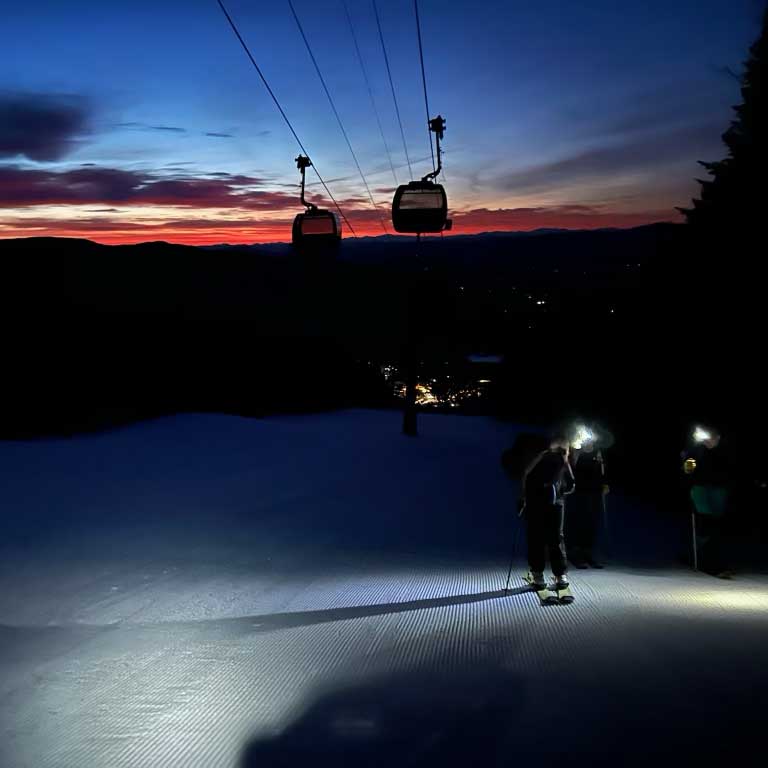
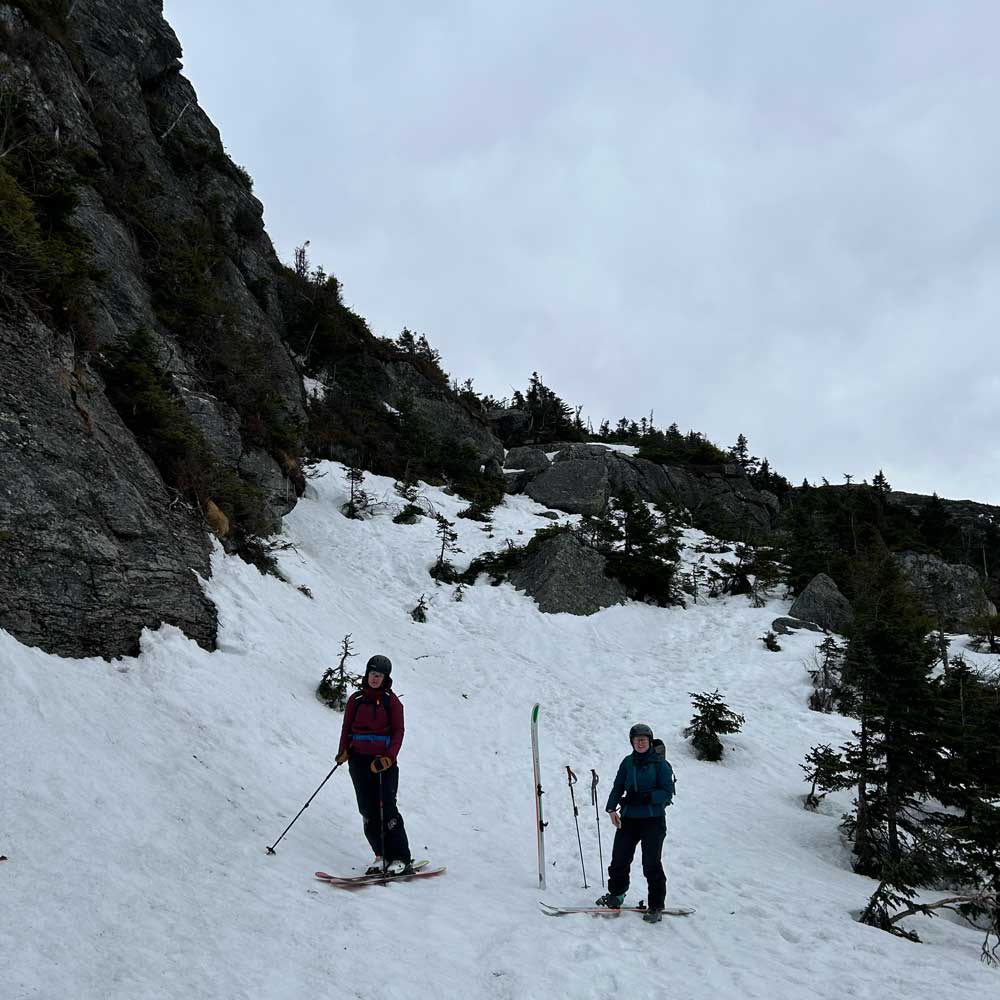
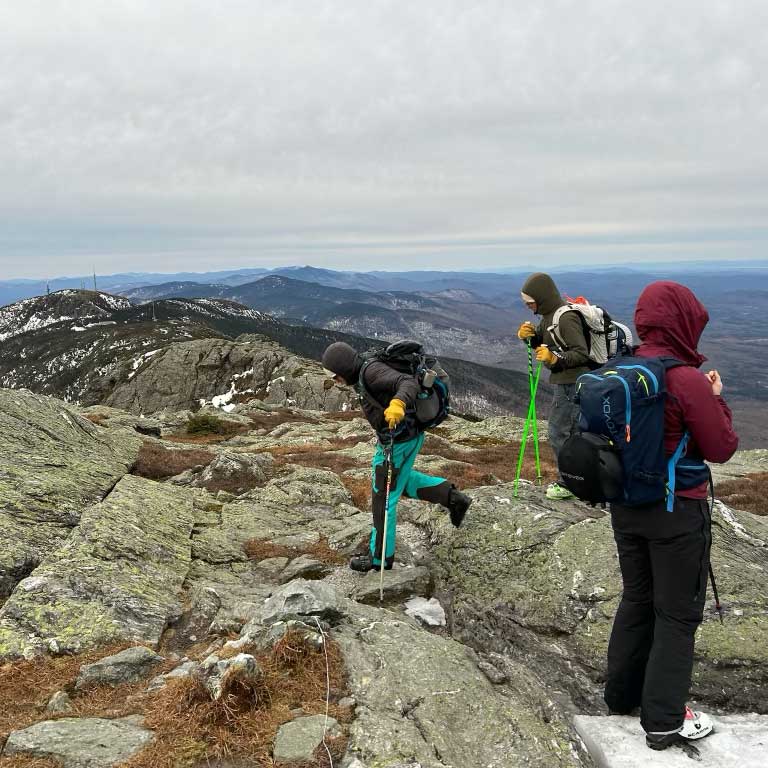
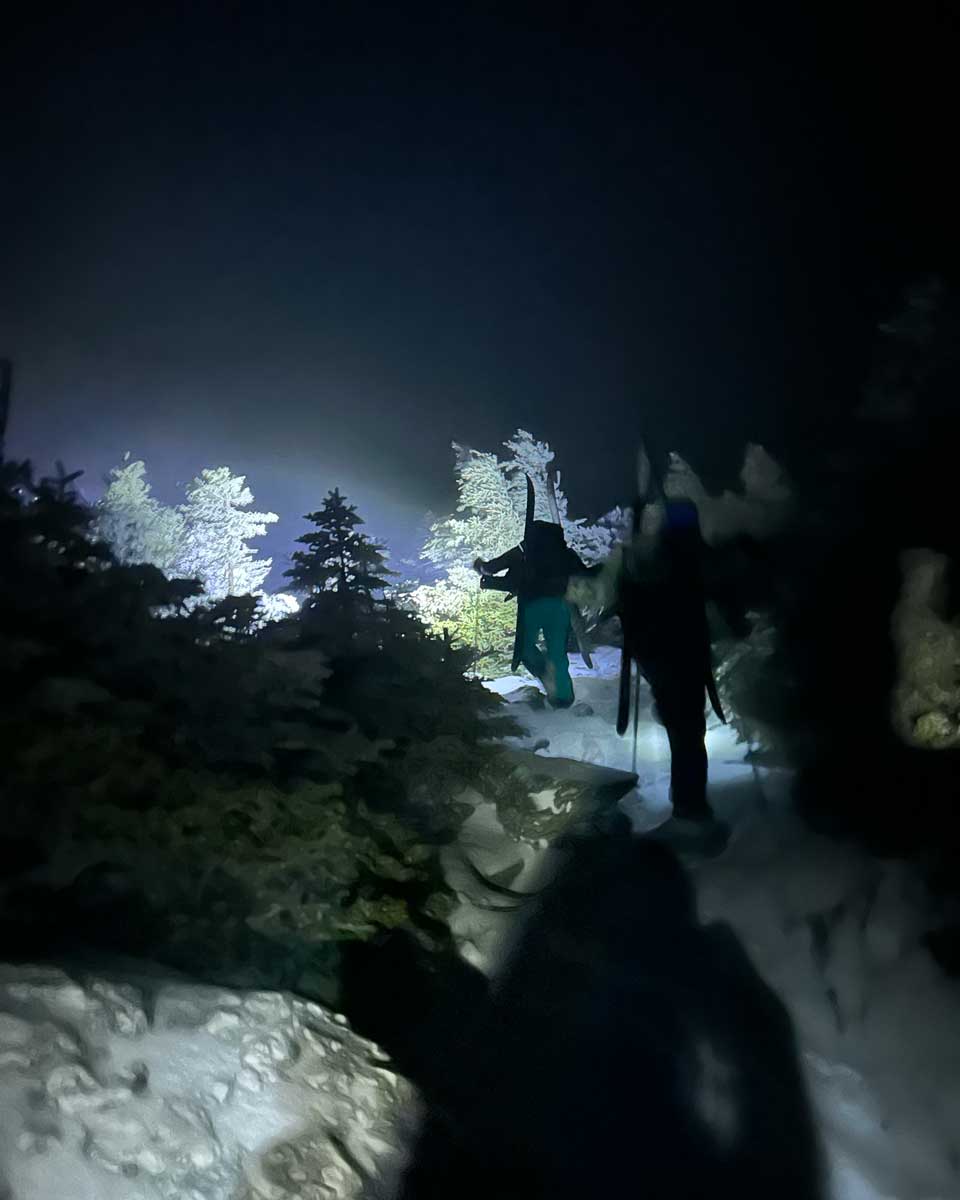
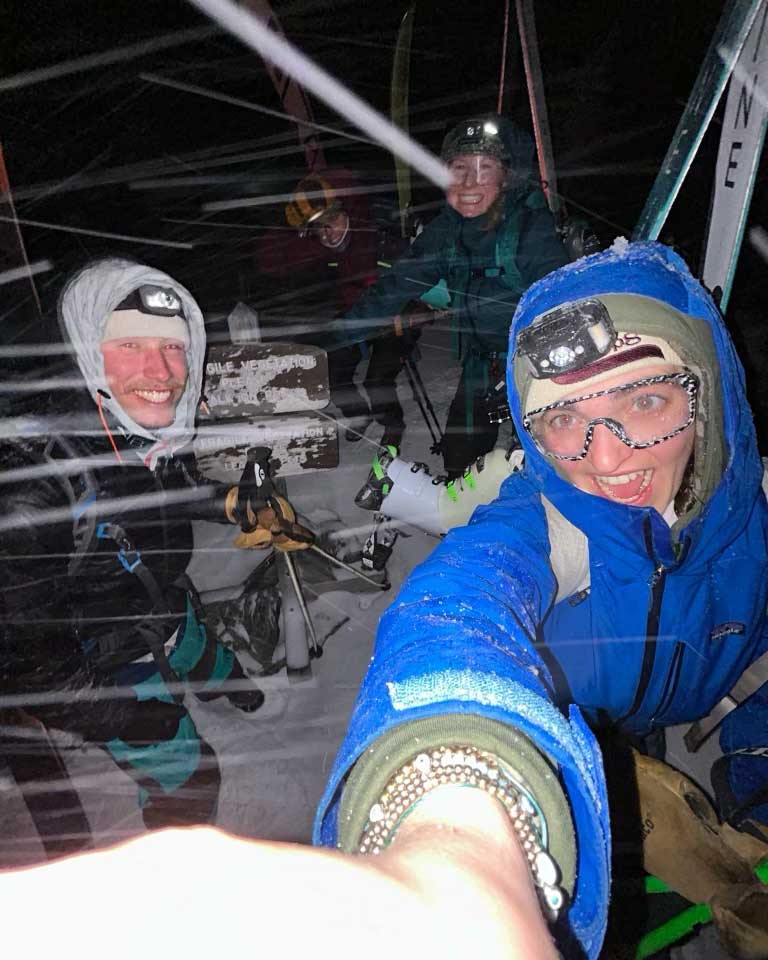
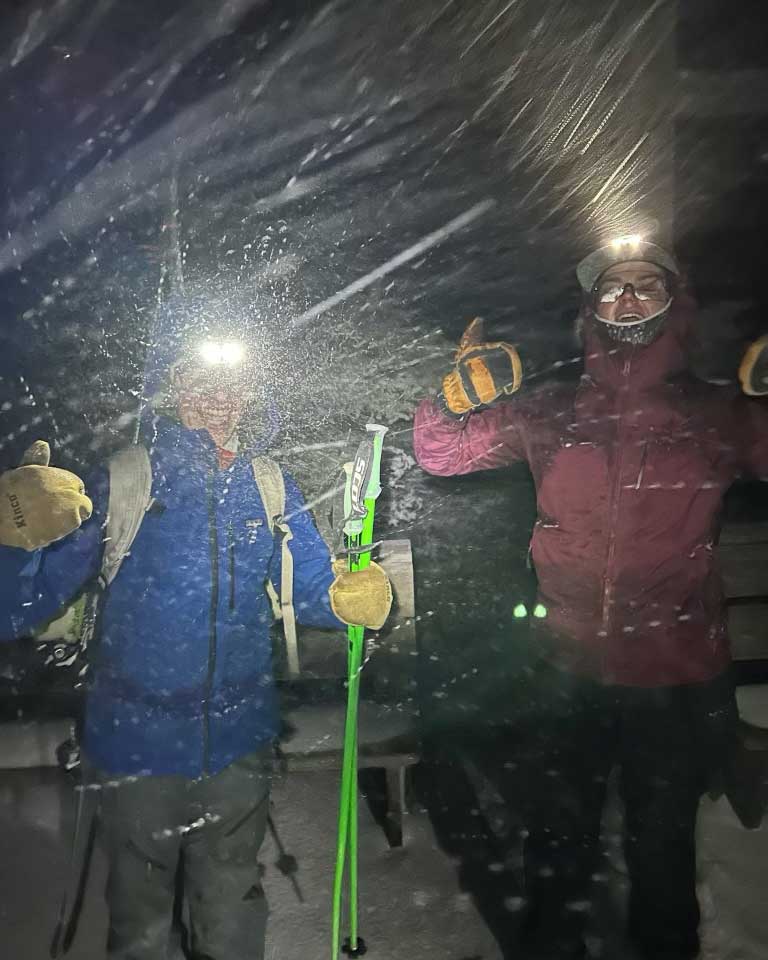
Carina
February 04, 2025
Stefanie, this made all of us at Bivo so happy to read too. Adventures like this are the best!